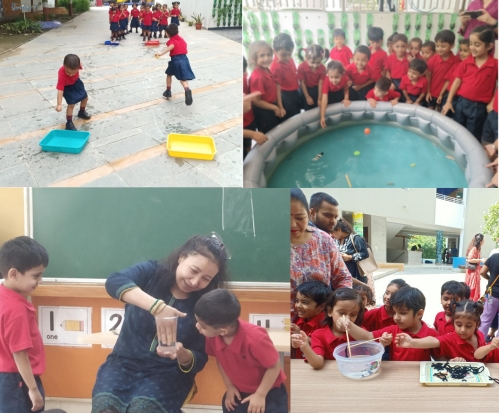


WONDERS OF WATER
About the project
Water is all around us. We drink it, bathe in it and wash our hands every day. Children love exploring and playing with water. The moment they see a little puddle outside after a rainy day, they would run to jump on it. Give them some spoons, lids and containers filled with water, they’ll scoop, pour, and explore, over and over, and over again. The theme, ‘Wonders of Water’ was aimed towards exploring the physical properties of water, its changing states, uses and sources; how rain is formed and its role in nature and finally, means to conserve water.
Driving Question
What is it that humans, animals and plants need for their survival? Where does it come from? How can we ensure we have more of it?
Process
The driving question led students of Ankur to the precious resource life on earth needs for its survival- clean water.
Their exploration into the question began with the story, ‘Pooh needs water.’ Through the story children learnt the various uses of water like, washing, bathing, boating, swimming and even painting. Children explored the physical properties of water and its changing states, through hands on experiments during the class. Engaging stories during ‘Tall Tales’ sessions such as ‘Drippy, the raindrop’ and ‘Nona aur Baarish’, helped them to understand how rain is formed, its role in nature and the need to save water.
‘Magic Pot’ sessions including science experiments such as ‘walking water’, ‘ice fishing’, ‘magnifying effect of water’, ‘dancing tea leaves’, etc. widened children’s perspective and made them curious leading to several questions.
During the ‘Nature Connect’ sessions, they watered the plants in their school garden, moved around the school corridors to look for leaking taps and turned them off tightly, whenever they found one. When they jumped on water puddles, made shoe marks and watched them disappear, they learnt about evaporation. They used the material that they collected during Nature Walk, such as leaves, pebbles, feathers, twigs, seeds, flowers etc. to see what sinks and what floats in water by dropping them in a splash pool. Children absolutely enjoyed the art activities using ‘water colours’ which enhanced their fine motor skills, eye hand coordination and imagination. ‘Pouring Stations’ with bowls, tubs, glasses, sponge, droppers, spoons, funnels, straws and ladles gave them an opportunity to explore it further as they squeezed, transferred and poured water from one container to another. While children enjoyed these pouring activities, they also discovered that there are certain materials that absorb water, such as sponge, cotton ball, cloth, etc. whereas there are others which do not absorb water such as a wooden block, plastic toys, thermocol balls, etc.
Besides the stories and experiments, videos, PowerPoint presentations and rhymes further helped the children to make their learning interesting, concrete and deep.

Project Culmination
The culmination event was held on 18th August 2023, where children presented songs and rhymes with actions that they learnt during their theme and enjoyed participating in various activities with their parents which showcased their learning through the theme. These activities included pouring stations, experiments such as sink and float, what absorbs and what do not, games such as aiming a target using a water gun, tossing water balloons through holes, fishing, creating and sailing paper boats, art activities such as blow, thread, bubble and magic painting.
Teacher Reflection
Children thoroughly enjoyed all the stories, rhymes, videos, games and hands-on activities conducted during the theme. Besides meeting their expected learning levels, they experienced important life skills such as pouring, transferring and judicious use of water. They understood that water is precious and must not be wasted. Listing out various ways of saving water towards the end made their learning authentic, deep and lifelong.
PRODUCTS AND DELIVERABLES
- Worksheets
MATERIALS USED
- Story Books
- Puppets
- Display Board
- Water Colours
- Crayons and Colour Pencils
- Pouring Equipment
- Resources for Activities
- PowerPoint Presentations
- Videos
















